Discover Florida Nature
It's time to explore the natural Florida


|
|
|
|
|
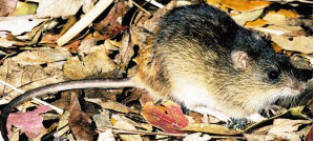 Sanibel
Island Rice Rat (Oryzomys palustris sanibeli) SSC- The Sanibel
Island rice rat is a medium sized rat that varies from 9-12.5 inches in
length. This rat has a sparsely haired tail that is approximately equal
in length to the head and body combined. Fur on the upper side of the
Sanibel Island rice rat is a brownish to buff and sometimes sprinkled
with black. The underside is a greyish white and the rat's feet are
white, with medium sized rounded ears. The Sanibel Island rice rat is
only found on Sanibel Island, in Lee County Florida. Sanibel
Island Rice Rat (Oryzomys palustris sanibeli) SSC- The Sanibel
Island rice rat is a medium sized rat that varies from 9-12.5 inches in
length. This rat has a sparsely haired tail that is approximately equal
in length to the head and body combined. Fur on the upper side of the
Sanibel Island rice rat is a brownish to buff and sometimes sprinkled
with black. The underside is a greyish white and the rat's feet are
white, with medium sized rounded ears. The Sanibel Island rice rat is
only found on Sanibel Island, in Lee County Florida.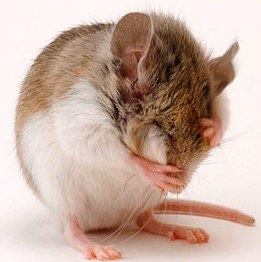 Choctawhatchee
Beach Mouse
(Peromyscus polionotus allophrys) Endangered- This is one of several
Florida subspecies of oldfield mouse restricted to coastal sand dune
ecosystems. These small, light-colored mice burrow and excavate nests
within dune sand among sea oats, grasses, herbs and small shrubs. These
burrows generally have a main hole and a second hole that is often used
to escape a predator at or within the main entrance. Unlike the house
mouse, beach mice are not known to live in buildings or frequent garbage
sites. The beach mouse's diet consists mostly of the seeds and fruits of
plants that grow among the dunes, including parts of sea oats, bluestem,
dune spurge, evening primrose, oaks, magnolias and youpon hollies.
Critical habitat is designated along 12.6 miles of coast in Walton and
Bay Counties, including Grayton Beach State Recreation Area and Topsail
Hill Preserve in Walton County, Shell Island and the mainland section of
St. Andrew State Recreation Area in Bay County. Choctawhatchee
Beach Mouse
(Peromyscus polionotus allophrys) Endangered- This is one of several
Florida subspecies of oldfield mouse restricted to coastal sand dune
ecosystems. These small, light-colored mice burrow and excavate nests
within dune sand among sea oats, grasses, herbs and small shrubs. These
burrows generally have a main hole and a second hole that is often used
to escape a predator at or within the main entrance. Unlike the house
mouse, beach mice are not known to live in buildings or frequent garbage
sites. The beach mouse's diet consists mostly of the seeds and fruits of
plants that grow among the dunes, including parts of sea oats, bluestem,
dune spurge, evening primrose, oaks, magnolias and youpon hollies.
Critical habitat is designated along 12.6 miles of coast in Walton and
Bay Counties, including Grayton Beach State Recreation Area and Topsail
Hill Preserve in Walton County, Shell Island and the mainland section of
St. Andrew State Recreation Area in Bay County.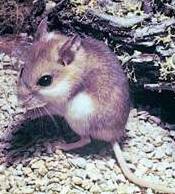 Southeastern
Beach Mouse (Peromyscus polionotus niveiventris) Threatened-
The Southeastern beach mouse is the largest beach mouse; it averages 139
millimeters in total length and 52 millimeters in tail length. Although
it is darker and more buffy than the Anastasia Island beach mouse, it is
still lighter than most inland subspecies of the oldfield mouse. The
Southeastern beach mouse lives in burrows in the sand dunes and comes
out at night to eat beach grasses and some invertebrates. Beach mice use
burrows, including those of ghost crabs, for temporary cover. Their
light coloration camouflages them against the sand. Southeastern
Beach Mouse (Peromyscus polionotus niveiventris) Threatened-
The Southeastern beach mouse is the largest beach mouse; it averages 139
millimeters in total length and 52 millimeters in tail length. Although
it is darker and more buffy than the Anastasia Island beach mouse, it is
still lighter than most inland subspecies of the oldfield mouse. The
Southeastern beach mouse lives in burrows in the sand dunes and comes
out at night to eat beach grasses and some invertebrates. Beach mice use
burrows, including those of ghost crabs, for temporary cover. Their
light coloration camouflages them against the sand.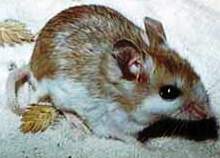 Anastasia
Island Beach Mouse (Peromyscus polionotus phasma) Endangered-
The endangered Anastasia Island Beach Mouse is one of several Florida
subspecies of oldfield mouse which lives among the sparse vegetation of
the coastal dune ecosystem. Looking like tan cotton balls with tails and
big eyes, they blend in very well with with the sand. They have a light
buff-colored back, pure white underparts, and indistinct, white markings
on its nose and face. The Anastasia Island beach mouse excavates nests
in the dunes, preferring sand-covered slopes with patches of sea oats.
The mice spend the day in the coolness of their burrows and roam the
dunes at night looking for insects and seeds from the dune grasses. The
Anastasia Island beach mouse lives in the sand dunes of Anastasia Island
and on the unnamed barrier island north of St. Augustine Inlet at the
Guana River State Park. Anastasia
Island Beach Mouse (Peromyscus polionotus phasma) Endangered-
The endangered Anastasia Island Beach Mouse is one of several Florida
subspecies of oldfield mouse which lives among the sparse vegetation of
the coastal dune ecosystem. Looking like tan cotton balls with tails and
big eyes, they blend in very well with with the sand. They have a light
buff-colored back, pure white underparts, and indistinct, white markings
on its nose and face. The Anastasia Island beach mouse excavates nests
in the dunes, preferring sand-covered slopes with patches of sea oats.
The mice spend the day in the coolness of their burrows and roam the
dunes at night looking for insects and seeds from the dune grasses. The
Anastasia Island beach mouse lives in the sand dunes of Anastasia Island
and on the unnamed barrier island north of St. Augustine Inlet at the
Guana River State Park. 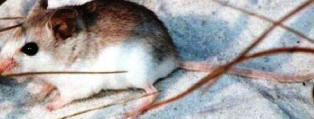 St.
Andrews Beach Mouse (Peromyscus polionotus peninsularis)
Endangered- Beach mice inhabit coastal dunes in the panhandle and along
the Atlantic coast of Florida.
Development of coastal areas has caused a loss of habitat for beach mice
and other plants and animals that live in the dunes. The St. Andrew
beach mouse, with its white feet, large ears, and black eyes, is one of
seven subspecies of beach mice that occur only in coastal sand dunes
where they excavate burrows and feed on plant seeds and insects. Unlike
house mice, beach mice do not seek out human dwellings or other
structures for food and shelter. St.
Andrews Beach Mouse (Peromyscus polionotus peninsularis)
Endangered- Beach mice inhabit coastal dunes in the panhandle and along
the Atlantic coast of Florida.
Development of coastal areas has caused a loss of habitat for beach mice
and other plants and animals that live in the dunes. The St. Andrew
beach mouse, with its white feet, large ears, and black eyes, is one of
seven subspecies of beach mice that occur only in coastal sand dunes
where they excavate burrows and feed on plant seeds and insects. Unlike
house mice, beach mice do not seek out human dwellings or other
structures for food and shelter. Perdido
Key Beach Mouse
(Peromyscus polionotus trissyllepsis) Endangered- The Perdido
Key beach mouse has a small body, haired tail, relatively large ears,
and protuberant eyes. The small white and gray mouse, weighing only
13-16 grams, blends in well with the white quartz sand of northern Gulf
coast beaches. The Perdido Key beach mouse is a nocturnal animal,
spending most daylight hours in their burrows. Unlike many species,
Beach Mice are monogamous, with mated pairs tending to remain together
as long as both live. A typical beach mouse pair averages 3-4 offspring
per litter and has roughly 3 litters per year While the Perdido Key
Beach Mouse feeds primarily on the seeds of sea oats and bluestem, it
will occasionally eat insects. Perdido
Key Beach Mouse
(Peromyscus polionotus trissyllepsis) Endangered- The Perdido
Key beach mouse has a small body, haired tail, relatively large ears,
and protuberant eyes. The small white and gray mouse, weighing only
13-16 grams, blends in well with the white quartz sand of northern Gulf
coast beaches. The Perdido Key beach mouse is a nocturnal animal,
spending most daylight hours in their burrows. Unlike many species,
Beach Mice are monogamous, with mated pairs tending to remain together
as long as both live. A typical beach mouse pair averages 3-4 offspring
per litter and has roughly 3 litters per year While the Perdido Key
Beach Mouse feeds primarily on the seeds of sea oats and bluestem, it
will occasionally eat insects.
|
|
|
Advertise | Privacy Statement | Dog Encyclopedia | Video |Contact | Alaska Nature |
|